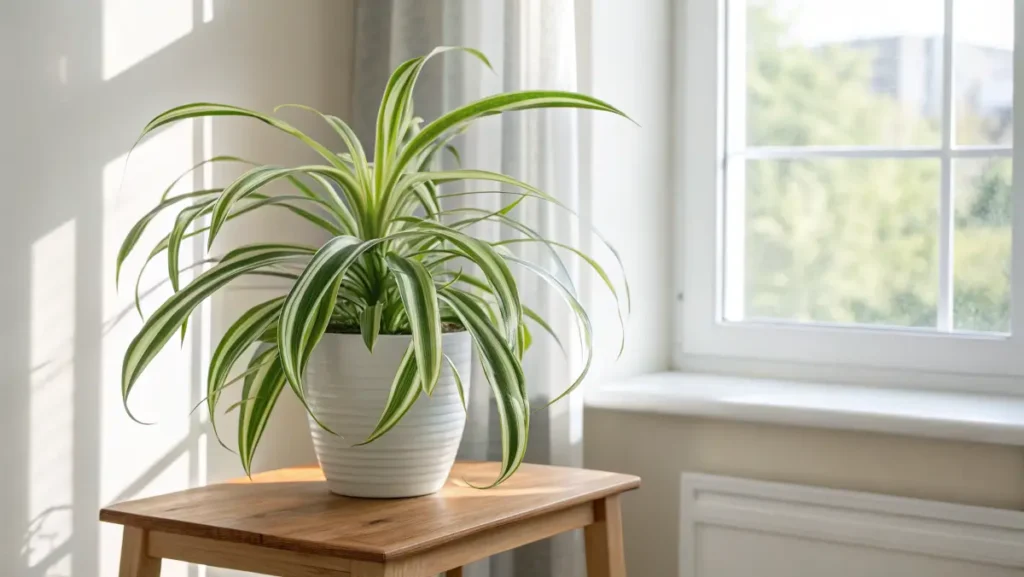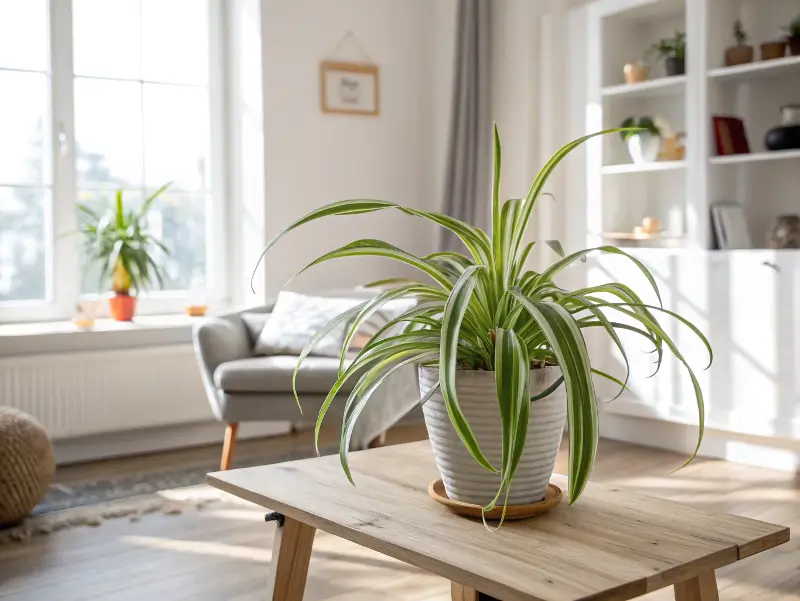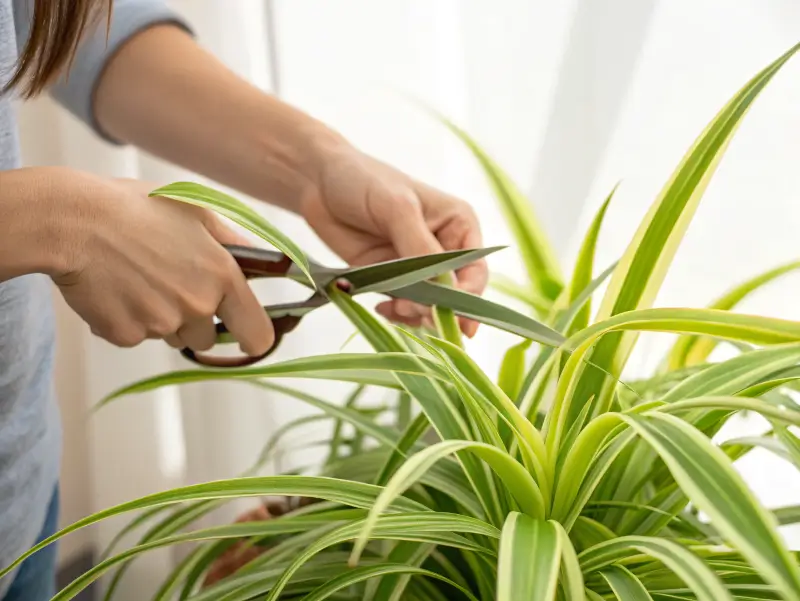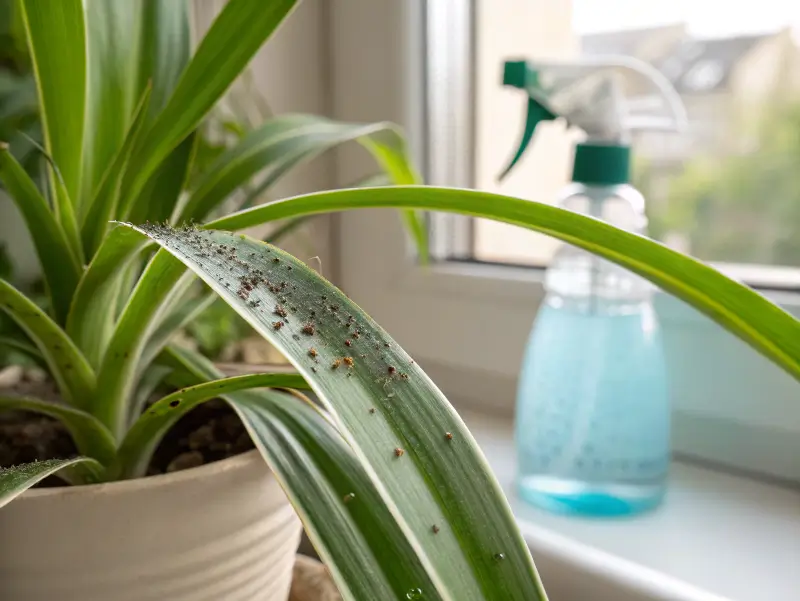
Ready to dive into spider plant care? In this short guide, discover easy watering tips, find the right pot, and handle adorable spiderettes like a pro. Enjoy quick tips, simple paragraphs, and very awesome comedic asides. Learn how seasonal shifts impact these green pals. By the end, you’ll feel confident about spider plant care and pairing them with other houseplants.
Table of Contents
Introduction to Spider Plant Care
Why Spider Plants are So Popular
I’ve been growing spider plants in my living room for a few years now, and I can’t stop gushing about them. People often call them airplane plants or ribbon plants, and each name hints at their playful, arching leaves. If you’re curious about chlorophytum spider plant care, trust me, it’s straightforward.
- They adapt to different lighting conditions—low light or bright, indirect sunlight.
- They’re practically made for indoor gardening tips.
- Their foliage stays perky, even when you forget a watering session.
That said, you might hear folks rave about spider plants care online. The best part? They kick off tiny “spider babies” (also known as spiderettes). Those adorable guys grow from shoots that dangle from the mother plant, ready to become new plants if you so choose. Honestly, I can’t help but get excited every time I see more spider plant care success stories floating around plant circles.
A Quick Word on Origins
Did you know that Chlorophytum comosum calls parts of Africa home? I love sharing this piece of trivia because it reminds me that spider plant care connects us to tropical environments, even if we live in a freezing region. The tropical houseplant care angle is easy to replicate indoors, as long as you pop them in decent potting medium and keep an eye on watering. Because these bright green leaves originated in warmer zones, it’s extra neat to see them adapt to a cozy windowsill in, say, Chicago or Seattle.
Ideal Light for Spider Plant Care
Bright Yet Gentle
Whenever I chat about spider plant care, I like to highlight light requirements. Right now, we’ve got longer days, so these plants are loving those extra hours of sunshine. However, direct noon sun through a bare window can scorch leaves.
- Place them near a curtain-filtered window.
- Try an east-facing window for soft morning rays.
- Skip intense afternoon sun to avoid leaf discoloration.
Even though they can manage low light, growth slows, and spiderettes might take their sweet time showing up. With a bit of bright, indirect sunlight, they’ll flourish quickly. My buddy refers to this sweet spot as “happy light,” which pretty much sums up spider plant care at its best.
Temperature and Humidity Basics
If you’ve got the temperature hovering between 65°F and 75°F, you’re golden. In spring 2025, we’re seeing wild temperature swings in some areas, but spider plants are champs at handling slight changes. Just don’t subject them to frigid nights below 50°F. Also, they appreciate moderate humidity:
- Group your plants together to create a humid micro-zone.
- Run a humidifier in winter to offset that dry air.
- Aim for a comfortable living space—if you feel good, they usually do too.
I find that consistent indoor warmth really makes spider plant care feel simple throughout the year.
Watering Essentials in Spider Plant Care

H3: How Often and How Much
I’ll be honest: I used to overwater. Yellowing leaves taught me to chill out. Now, I let the top inch of soil dry before I water. Then I pour until water drips from the drainage holes—simple yet effective. If I’m unsure, I do the “finger test” to confirm dryness.
- Overwatering leads to root rot prevention nightmares.
- Sudden droopiness might be a clue you’ve gone too long without watering.
- Adjust frequency in hotter summers—these guys drink more when it’s warmer.
Because spider plant care is forgiving, it’s easy to bounce back if you slip up once or twice. Plus, the leaves themselves look kind of droopy if they’re too thirsty, giving you a nudge to get that watering can. In my opinion, these subtle leaf signals make spider plant care feel almost like a conversation with your plant.
H3: Simplifying Drainage
Let’s face it: drainage is key. If water pools at the bottom of the pot, your roots might suffocate. Whenever I mention chlorophytum spider plant care, I emphasize:
- Use pots with sturdy drainage holes.
- Consider a pebble tray to catch runoff and bump humidity a bit.
- Opt for a chunky potting mix that includes perlite or sand.
By avoiding soggy soil, you protect the plant from root issues. Root rot is a bummer that can creep up if you keep the soil soggy for too long. If you see any weird smells or brown mushy roots, think about repotting in fresh media. Trust me, saving an overwatered spider might be easier than you think because spider plant care has plenty of room for small mistakes.
Soil and Fertilizer for Spider Plants Care
Picking the Right Soil
I keep it light and airy, choosing a commercial mix with perlite. It helps water drain quickly, preventing future watery disasters. Some folks go for peat-based mixes; others add coco coir. Truth is, you can get away with many blends as long as they aren’t dense. Remember:
- Loose mediums help oxygen reach the roots.
- Soil that packs down can suffocate healthy growth.
- A slightly acidic to neutral pH often fits spider plant care nicely.
You don’t need fancy special mixes. Grab a basic houseplant bag at your local garden store and toss in a handful of perlite. That’s usually plenty for everyday spider plant care success.
Low-Stress Feeding
Fertilizer talk can feel intimidating, but spider plants care is so chill. Every month or two in spring and summer, I pour a balanced liquid fertilizer at half-strength. That nudge helps new leaves pop up in brighter green hues. Watch for overfeeding signs though—brown tips can result from salt buildup in the soil.
- Flush the soil occasionally by watering thoroughly.
- If leaves look scorched, back off on the fertilizer.
- In dormant seasons, feed less, maybe once every six weeks.
I’ve personally found that gentle feeding is all you need for spider plant care—no fancy fertilizer schedules required.
Pruning and Dealing with Brown Tips

Caring for Crispy Edges
A common question in spider plant care circles is: “What do I do with these ugly brown tips?” Quite often, it points to:
- Low humidity
- Salt buildup
- Fertilizer burn
- Hard tap water
If it’s just the tip, trim off that crispy section with clean scissors. Don’t chop into healthy tissue. Meanwhile, see if using filtered water helps. Or consider feeding less. If the problem persists, you may want to tweak your environment or your watering routine. Keeping an eye on these details is a big part of spider plant care.
Tidying Up Old Leaves
I sometimes spot older leaves turning yellow at the base. No big deal. It’s normal for them to drop older leaves as fresh shoots sprout. Simply remove the faded part to let your plant channel energy into healthy new leaves. If you find your pot overcrowded, consider dividing the root ball. Let’s be honest, it’s kinda gratifying to watch your spider plant care routine pay off with lush, green growth.
Propagation and Spiderettes
Spotting Those Dainty Babies
Nothing beats the excitement of seeing spiderettes dangle from the parent. It’s like a free gift you didn’t know you’d get. I recall my first spiderette—I almost squealed. These baby plants appear on thin runners, sprouting leaves that look like mini versions of the parent. This is where spider plants care turns super fun.
- They show up more often when the parent is healthy and getting bright light.
- They develop short roots while still attached.
- They’re easy to root in either water or soil.
Many folks share these offshoots with friends, effectively spreading the joy of spider plant care around town.
Easy Propagation Steps
If the baby has wee roots, snip it off gently:
- Place it in water for a few days while roots develop further.
- Transfer it into a small pot of fresh potting mix.
- Water sparingly until it’s established.
Alternatively, you can plug the baby directly into soil. Keep the medium lightly moist, and watch for signs of growth. Soon enough, you’ll have your own mini forest of spider plants, which might lead you to start handing them out like party favors. (I’ve done that with neighbors, and it’s a blast.)
Common Problems and Quick Fixes

Recognizing Pests and Disease
Like many houseplants, spider plants can battle aphids or spider mites. If you notice tiny bugs or webbing, wipe the leaves with a little soapy water or an insecticidal soap. Quick action is vital:
- Pests multiply fast.
- Isolate the affected plant.
- Trim heavily infested leaves if needed.
If issues persist, you can check the USDA site for safe pesticide info. In spider plant care circles, we usually stick to gentle methods first because these plants respond well to mild treatments.
Overwatering and Root Troubles
When a plant looks limp even though soil is damp, you might have root decay. I once lost a spider plant that was placed in a non-draining pot. Lesson learned. If you suspect rot:
- Take it out of the pot and examine the roots.
- Snip off brown, squishy parts.
- Repot into fresh soil.
Acting sooner rather than later can save the day. Because spider plant care is fairly forgiving, they might bounce back from partial root loss if you catch it early enough.
Indoor Styling with Spider Plant Care
Pairing with Other Houseplants
In my place, I like to group spider plants alongside a White Wizard Philodendron for a bold arrangement of light and dark leaves. Both plants love moderate humidity and bright, indirect sunshine, so they coexist nicely. Sometimes, I’ll even add a White Bird of Paradise plant to create a mini indoor jungle. The result? A calm, refreshing corner that highlights my love for spider plant care.
Using Creative Displays
I’ve experimented with macramé hangers, flanking them by a sunny window, or placing them on bookshelves to fill empty corners. Spider plants care isn’t limited to windowsills. They look awesome in hanging baskets, especially when spiderettes start forming. Just be mindful of strong midday sun.
My friend once hung hers on a porch that got direct rays in August, and the leaves turned pale. A quick move indoors saved it, so don’t be afraid to shuffle them around if you see signs of stress. Trust your gut—part of spider plant care is learning to read your plant’s signals.
Seasonal Adjustments for Spider Plants Care
Summer vs. Winter Routines
You might wonder how the changing seasons impact spider plant care. In summer, the plant may suck up more water, so you’ll need to hydrate it more often. Also, watch out for scorching rays through west-facing windows. In winter:
- Reduce watering frequency.
- Keep them away from cold drafts.
- Consider using a humidifier if you blast the heater.
Each season has its quirks. But because spider plants are tough, small tweaks keep them steady. Years ago, I almost let one freeze by an uninsulated window in January. Whoops. I moved it away just in time, and it recovered—another reason spider plant care is so rewarding.
Holiday or Vacation Hacks
Headed out of town for a week? Water right before you leave, and you’ll likely be fine. If you’re gone longer, set up a simple self-watering system or ask a neighbor to drop by. Spider plant care doesn’t need daily check-ins, but if you’re away for a double-digit number of days, a friendly caretaker helps. Sometimes, I even show my friend how to do the “finger test” for dryness so they don’t drown my plants. That level of trust might mean your spider plants care is top-notch without you around.
FAQs on Spider Plant Care
Should I Trim Brown Tips?
Yes, if only the edges are brown. Use clean scissors, cut just past the discolored part, and keep the rest of the leaf intact. I do this regularly to maintain a crisp look. It also helps track if the issue continues or if the changes you made (filtered water, less fertilizer, etc.) solved the problem. Tweaking spider plant care steps after spotting repeated browning is a surefire path to healthier leaves.
Do They Really Clean the Air?
Some folks say spider plants purify air, gobbling up indoor toxins. While it’s a popular notion, there’s still debate over how much they really remove. Either way, they sure liven up a room, and I think that alone is a gift. If you want more official data on indoor air quality, the EPA sometimes shares helpful tips. Adding spider plant care to your routine definitely won’t hurt.
Why Am I Not Getting Babies?
If your spider plant seems baby-free, consider boosting its light. I had one plant in a dark corner for months, and it never sprang babies. Once I shifted it closer to a brighter window, spiderettes popped up within weeks. Also, older, stable plants tend to produce more offshoots. Spider plant care pays off when the parent feels content enough to expand.
How Often Do I Repot?
I check the roots about once a year. If they’re circling the bottom or bulging up top, time for a bigger container. Chlorophytum spider plant care thrives when roots have room. Usually, I just bump up one pot size every year or two.
Conclusion and More Thoughts on Spider Plant Care
Recap of Key Points
- Spider plant care isn’t complicated—moderate indirect light, decent watering, and occasional feeding.
- Avoid waterlogged soil to prevent rot.
- Trim brown bits often if they appear.
- Expect adorable spiderettes if your plant settles in happily.
I’ve come to love the casual vibe these plants bring. Even if you’re super busy, spider plant care doesn’t demand heaps of your time. They’re the reliable pals of the plant world, bouncing back from a missed watering or a rough winter draft. That alone makes spider plant care a favorite among both newbies and plant pros.
